Infographic and Rationale | Assignment 2
VerifiedAdded on 2022/09/18
|7
|1789
|24
AI Summary
Contribute Materials
Your contribution can guide someone’s learning journey. Share your
documents today.
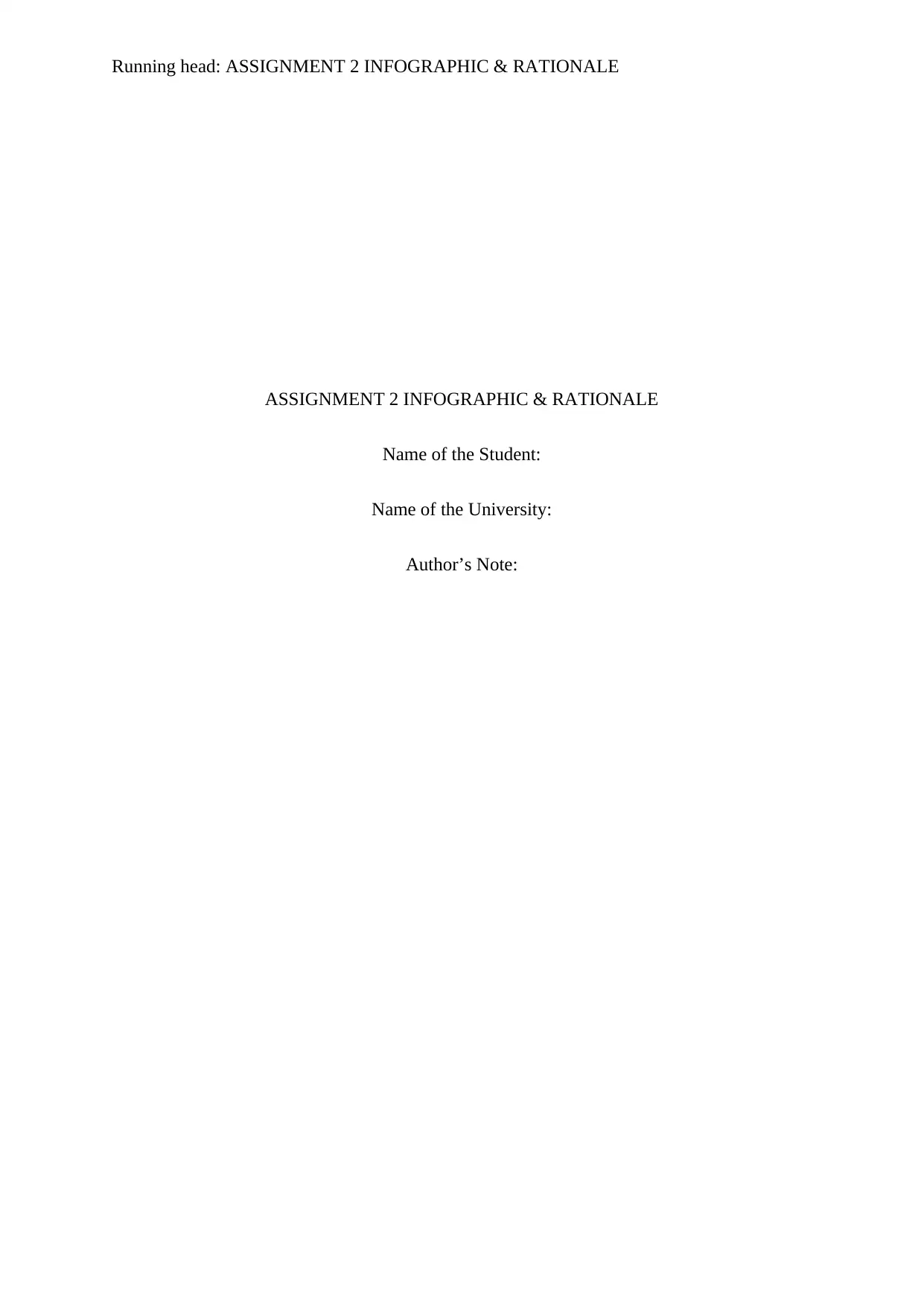
Running head: ASSIGNMENT 2 INFOGRAPHIC & RATIONALE
ASSIGNMENT 2 INFOGRAPHIC & RATIONALE
Name of the Student:
Name of the University:
Author’s Note:
ASSIGNMENT 2 INFOGRAPHIC & RATIONALE
Name of the Student:
Name of the University:
Author’s Note:
Secure Best Marks with AI Grader
Need help grading? Try our AI Grader for instant feedback on your assignments.
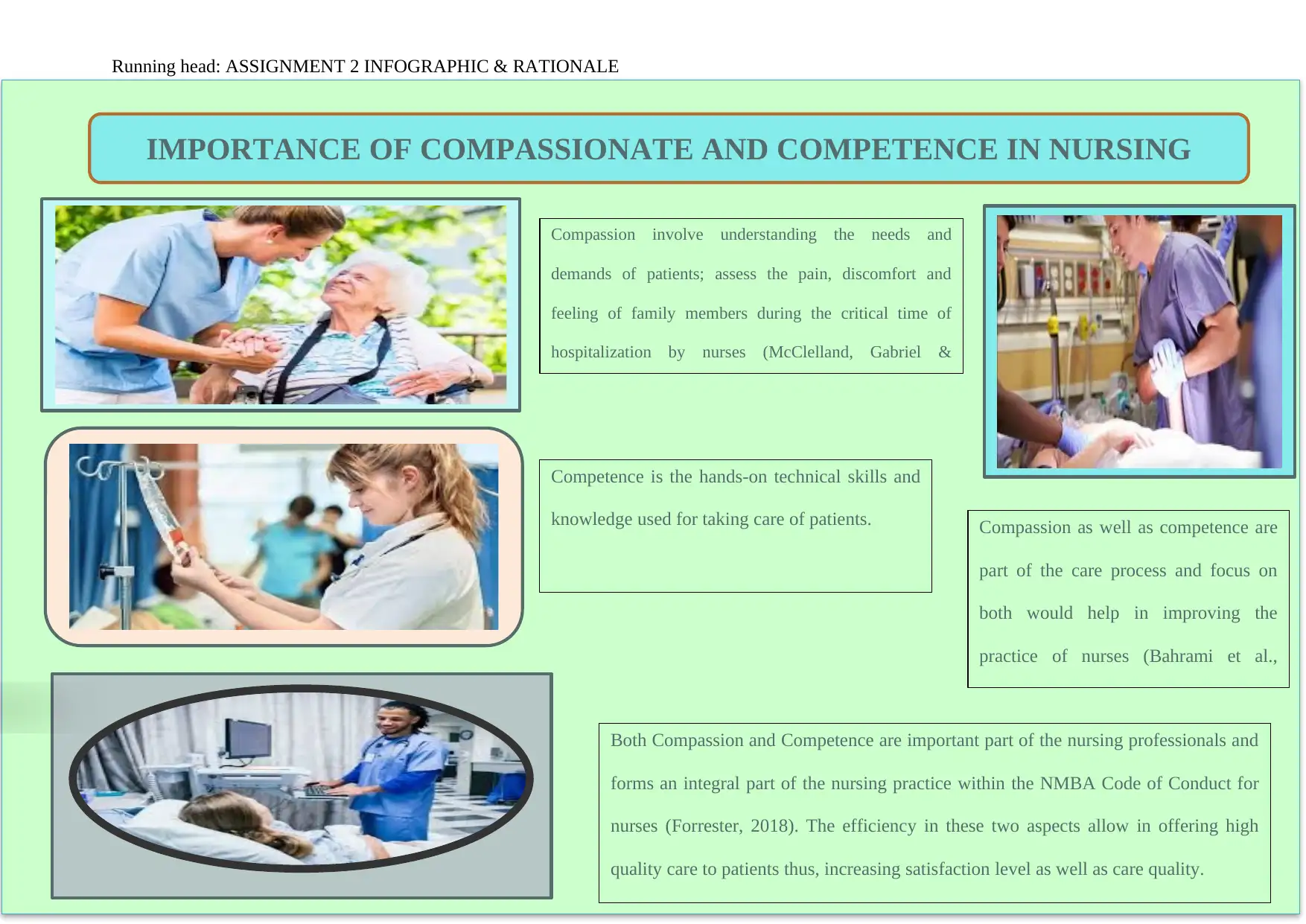
Running head: ASSIGNMENT 2 INFOGRAPHIC & RATIONALE
IMPORTANCE OF COMPASSIONATE AND COMPETENCE IN NURSING
Compassion involve understanding the needs and
demands of patients; assess the pain, discomfort and
feeling of family members during the critical time of
hospitalization by nurses (McClelland, Gabriel &
DePuccio, 2019).
Competence is the hands-on technical skills and
knowledge used for taking care of patients.
Both Compassion and Competence are important part of the nursing professionals and
forms an integral part of the nursing practice within the NMBA Code of Conduct for
nurses (Forrester, 2018). The efficiency in these two aspects allow in offering high
quality care to patients thus, increasing satisfaction level as well as care quality.
Compassion as well as competence are
part of the care process and focus on
both would help in improving the
practice of nurses (Bahrami et al.,
2019).
IMPORTANCE OF COMPASSIONATE AND COMPETENCE IN NURSING
Compassion involve understanding the needs and
demands of patients; assess the pain, discomfort and
feeling of family members during the critical time of
hospitalization by nurses (McClelland, Gabriel &
DePuccio, 2019).
Competence is the hands-on technical skills and
knowledge used for taking care of patients.
Both Compassion and Competence are important part of the nursing professionals and
forms an integral part of the nursing practice within the NMBA Code of Conduct for
nurses (Forrester, 2018). The efficiency in these two aspects allow in offering high
quality care to patients thus, increasing satisfaction level as well as care quality.
Compassion as well as competence are
part of the care process and focus on
both would help in improving the
practice of nurses (Bahrami et al.,
2019).
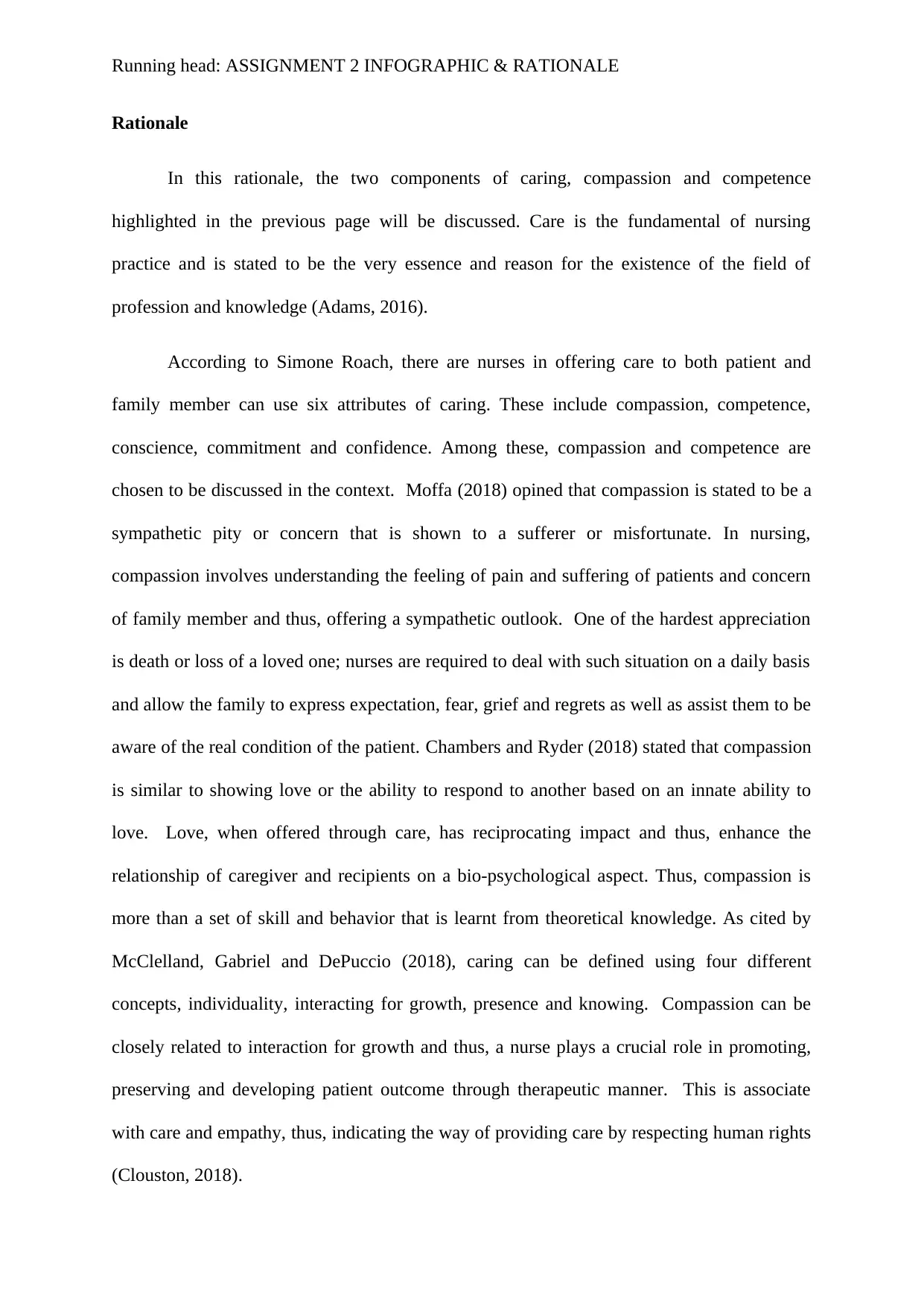
Running head: ASSIGNMENT 2 INFOGRAPHIC & RATIONALE
Rationale
In this rationale, the two components of caring, compassion and competence
highlighted in the previous page will be discussed. Care is the fundamental of nursing
practice and is stated to be the very essence and reason for the existence of the field of
profession and knowledge (Adams, 2016).
According to Simone Roach, there are nurses in offering care to both patient and
family member can use six attributes of caring. These include compassion, competence,
conscience, commitment and confidence. Among these, compassion and competence are
chosen to be discussed in the context. Moffa (2018) opined that compassion is stated to be a
sympathetic pity or concern that is shown to a sufferer or misfortunate. In nursing,
compassion involves understanding the feeling of pain and suffering of patients and concern
of family member and thus, offering a sympathetic outlook. One of the hardest appreciation
is death or loss of a loved one; nurses are required to deal with such situation on a daily basis
and allow the family to express expectation, fear, grief and regrets as well as assist them to be
aware of the real condition of the patient. Chambers and Ryder (2018) stated that compassion
is similar to showing love or the ability to respond to another based on an innate ability to
love. Love, when offered through care, has reciprocating impact and thus, enhance the
relationship of caregiver and recipients on a bio-psychological aspect. Thus, compassion is
more than a set of skill and behavior that is learnt from theoretical knowledge. As cited by
McClelland, Gabriel and DePuccio (2018), caring can be defined using four different
concepts, individuality, interacting for growth, presence and knowing. Compassion can be
closely related to interaction for growth and thus, a nurse plays a crucial role in promoting,
preserving and developing patient outcome through therapeutic manner. This is associate
with care and empathy, thus, indicating the way of providing care by respecting human rights
(Clouston, 2018).
Rationale
In this rationale, the two components of caring, compassion and competence
highlighted in the previous page will be discussed. Care is the fundamental of nursing
practice and is stated to be the very essence and reason for the existence of the field of
profession and knowledge (Adams, 2016).
According to Simone Roach, there are nurses in offering care to both patient and
family member can use six attributes of caring. These include compassion, competence,
conscience, commitment and confidence. Among these, compassion and competence are
chosen to be discussed in the context. Moffa (2018) opined that compassion is stated to be a
sympathetic pity or concern that is shown to a sufferer or misfortunate. In nursing,
compassion involves understanding the feeling of pain and suffering of patients and concern
of family member and thus, offering a sympathetic outlook. One of the hardest appreciation
is death or loss of a loved one; nurses are required to deal with such situation on a daily basis
and allow the family to express expectation, fear, grief and regrets as well as assist them to be
aware of the real condition of the patient. Chambers and Ryder (2018) stated that compassion
is similar to showing love or the ability to respond to another based on an innate ability to
love. Love, when offered through care, has reciprocating impact and thus, enhance the
relationship of caregiver and recipients on a bio-psychological aspect. Thus, compassion is
more than a set of skill and behavior that is learnt from theoretical knowledge. As cited by
McClelland, Gabriel and DePuccio (2018), caring can be defined using four different
concepts, individuality, interacting for growth, presence and knowing. Compassion can be
closely related to interaction for growth and thus, a nurse plays a crucial role in promoting,
preserving and developing patient outcome through therapeutic manner. This is associate
with care and empathy, thus, indicating the way of providing care by respecting human rights
(Clouston, 2018).
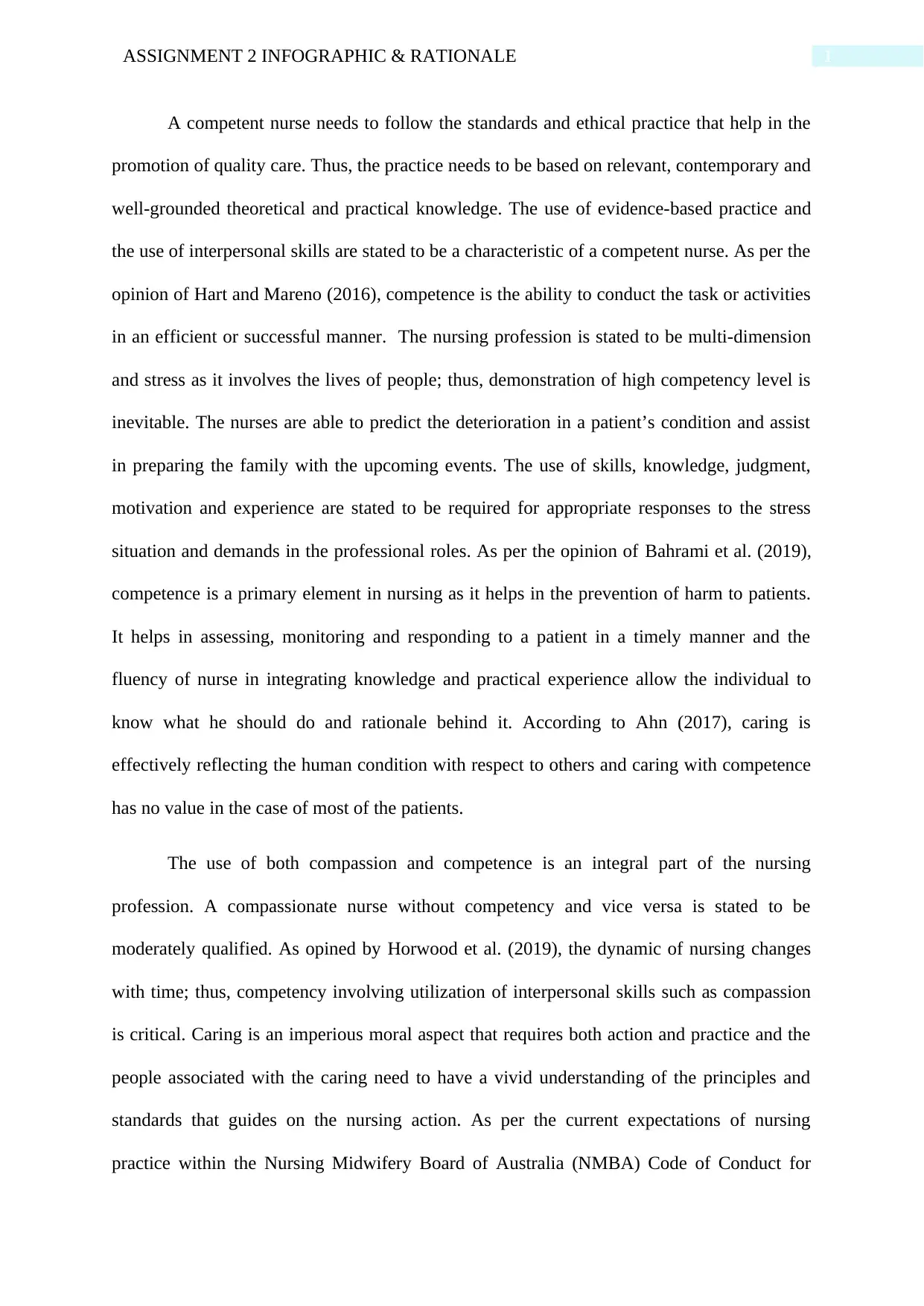
1ASSIGNMENT 2 INFOGRAPHIC & RATIONALE
A competent nurse needs to follow the standards and ethical practice that help in the
promotion of quality care. Thus, the practice needs to be based on relevant, contemporary and
well-grounded theoretical and practical knowledge. The use of evidence-based practice and
the use of interpersonal skills are stated to be a characteristic of a competent nurse. As per the
opinion of Hart and Mareno (2016), competence is the ability to conduct the task or activities
in an efficient or successful manner. The nursing profession is stated to be multi-dimension
and stress as it involves the lives of people; thus, demonstration of high competency level is
inevitable. The nurses are able to predict the deterioration in a patient’s condition and assist
in preparing the family with the upcoming events. The use of skills, knowledge, judgment,
motivation and experience are stated to be required for appropriate responses to the stress
situation and demands in the professional roles. As per the opinion of Bahrami et al. (2019),
competence is a primary element in nursing as it helps in the prevention of harm to patients.
It helps in assessing, monitoring and responding to a patient in a timely manner and the
fluency of nurse in integrating knowledge and practical experience allow the individual to
know what he should do and rationale behind it. According to Ahn (2017), caring is
effectively reflecting the human condition with respect to others and caring with competence
has no value in the case of most of the patients.
The use of both compassion and competence is an integral part of the nursing
profession. A compassionate nurse without competency and vice versa is stated to be
moderately qualified. As opined by Horwood et al. (2019), the dynamic of nursing changes
with time; thus, competency involving utilization of interpersonal skills such as compassion
is critical. Caring is an imperious moral aspect that requires both action and practice and the
people associated with the caring need to have a vivid understanding of the principles and
standards that guides on the nursing action. As per the current expectations of nursing
practice within the Nursing Midwifery Board of Australia (NMBA) Code of Conduct for
A competent nurse needs to follow the standards and ethical practice that help in the
promotion of quality care. Thus, the practice needs to be based on relevant, contemporary and
well-grounded theoretical and practical knowledge. The use of evidence-based practice and
the use of interpersonal skills are stated to be a characteristic of a competent nurse. As per the
opinion of Hart and Mareno (2016), competence is the ability to conduct the task or activities
in an efficient or successful manner. The nursing profession is stated to be multi-dimension
and stress as it involves the lives of people; thus, demonstration of high competency level is
inevitable. The nurses are able to predict the deterioration in a patient’s condition and assist
in preparing the family with the upcoming events. The use of skills, knowledge, judgment,
motivation and experience are stated to be required for appropriate responses to the stress
situation and demands in the professional roles. As per the opinion of Bahrami et al. (2019),
competence is a primary element in nursing as it helps in the prevention of harm to patients.
It helps in assessing, monitoring and responding to a patient in a timely manner and the
fluency of nurse in integrating knowledge and practical experience allow the individual to
know what he should do and rationale behind it. According to Ahn (2017), caring is
effectively reflecting the human condition with respect to others and caring with competence
has no value in the case of most of the patients.
The use of both compassion and competence is an integral part of the nursing
profession. A compassionate nurse without competency and vice versa is stated to be
moderately qualified. As opined by Horwood et al. (2019), the dynamic of nursing changes
with time; thus, competency involving utilization of interpersonal skills such as compassion
is critical. Caring is an imperious moral aspect that requires both action and practice and the
people associated with the caring need to have a vivid understanding of the principles and
standards that guides on the nursing action. As per the current expectations of nursing
practice within the Nursing Midwifery Board of Australia (NMBA) Code of Conduct for
Secure Best Marks with AI Grader
Need help grading? Try our AI Grader for instant feedback on your assignments.
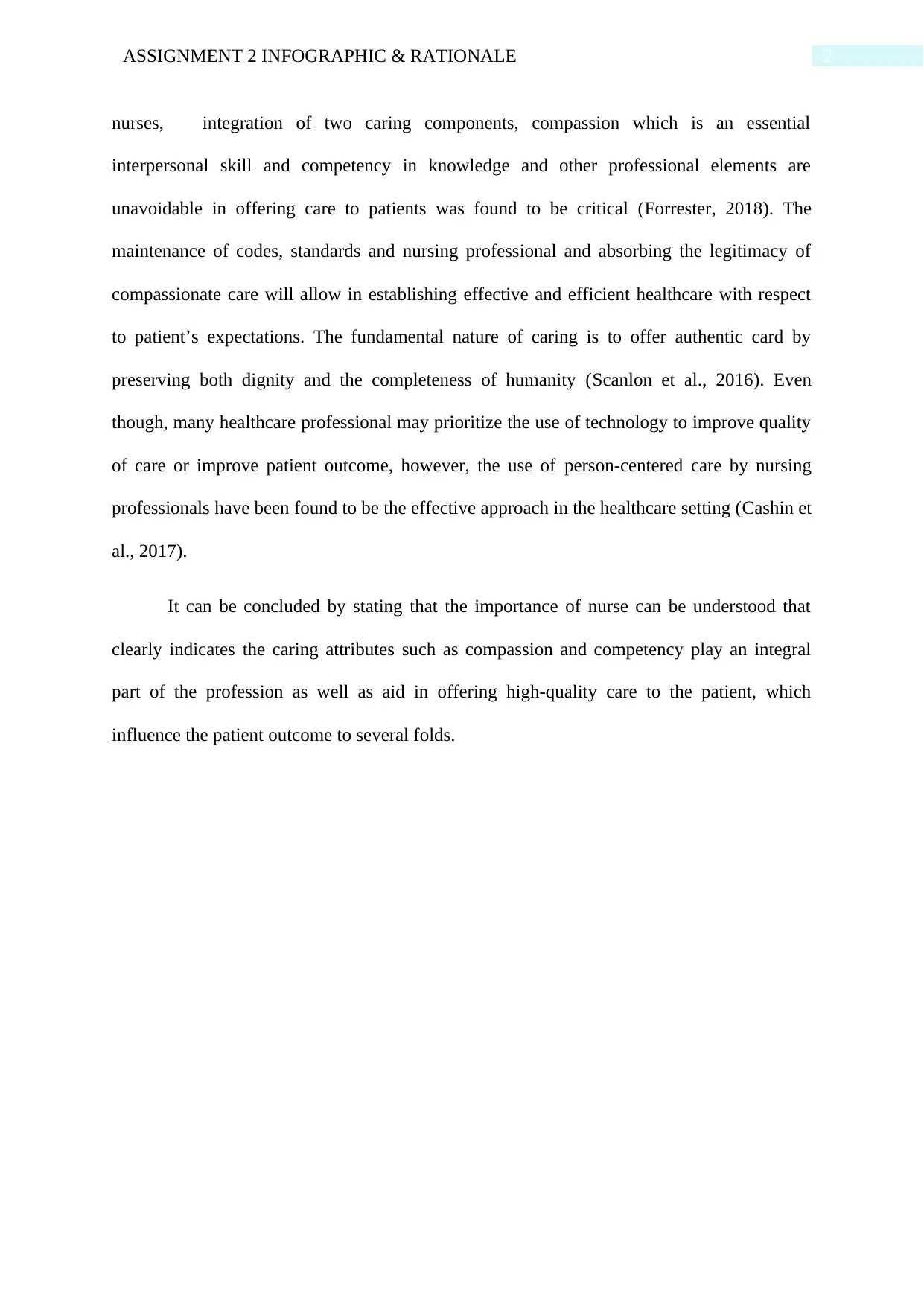
2ASSIGNMENT 2 INFOGRAPHIC & RATIONALE
nurses, integration of two caring components, compassion which is an essential
interpersonal skill and competency in knowledge and other professional elements are
unavoidable in offering care to patients was found to be critical (Forrester, 2018). The
maintenance of codes, standards and nursing professional and absorbing the legitimacy of
compassionate care will allow in establishing effective and efficient healthcare with respect
to patient’s expectations. The fundamental nature of caring is to offer authentic card by
preserving both dignity and the completeness of humanity (Scanlon et al., 2016). Even
though, many healthcare professional may prioritize the use of technology to improve quality
of care or improve patient outcome, however, the use of person-centered care by nursing
professionals have been found to be the effective approach in the healthcare setting (Cashin et
al., 2017).
It can be concluded by stating that the importance of nurse can be understood that
clearly indicates the caring attributes such as compassion and competency play an integral
part of the profession as well as aid in offering high-quality care to the patient, which
influence the patient outcome to several folds.
nurses, integration of two caring components, compassion which is an essential
interpersonal skill and competency in knowledge and other professional elements are
unavoidable in offering care to patients was found to be critical (Forrester, 2018). The
maintenance of codes, standards and nursing professional and absorbing the legitimacy of
compassionate care will allow in establishing effective and efficient healthcare with respect
to patient’s expectations. The fundamental nature of caring is to offer authentic card by
preserving both dignity and the completeness of humanity (Scanlon et al., 2016). Even
though, many healthcare professional may prioritize the use of technology to improve quality
of care or improve patient outcome, however, the use of person-centered care by nursing
professionals have been found to be the effective approach in the healthcare setting (Cashin et
al., 2017).
It can be concluded by stating that the importance of nurse can be understood that
clearly indicates the caring attributes such as compassion and competency play an integral
part of the profession as well as aid in offering high-quality care to the patient, which
influence the patient outcome to several folds.
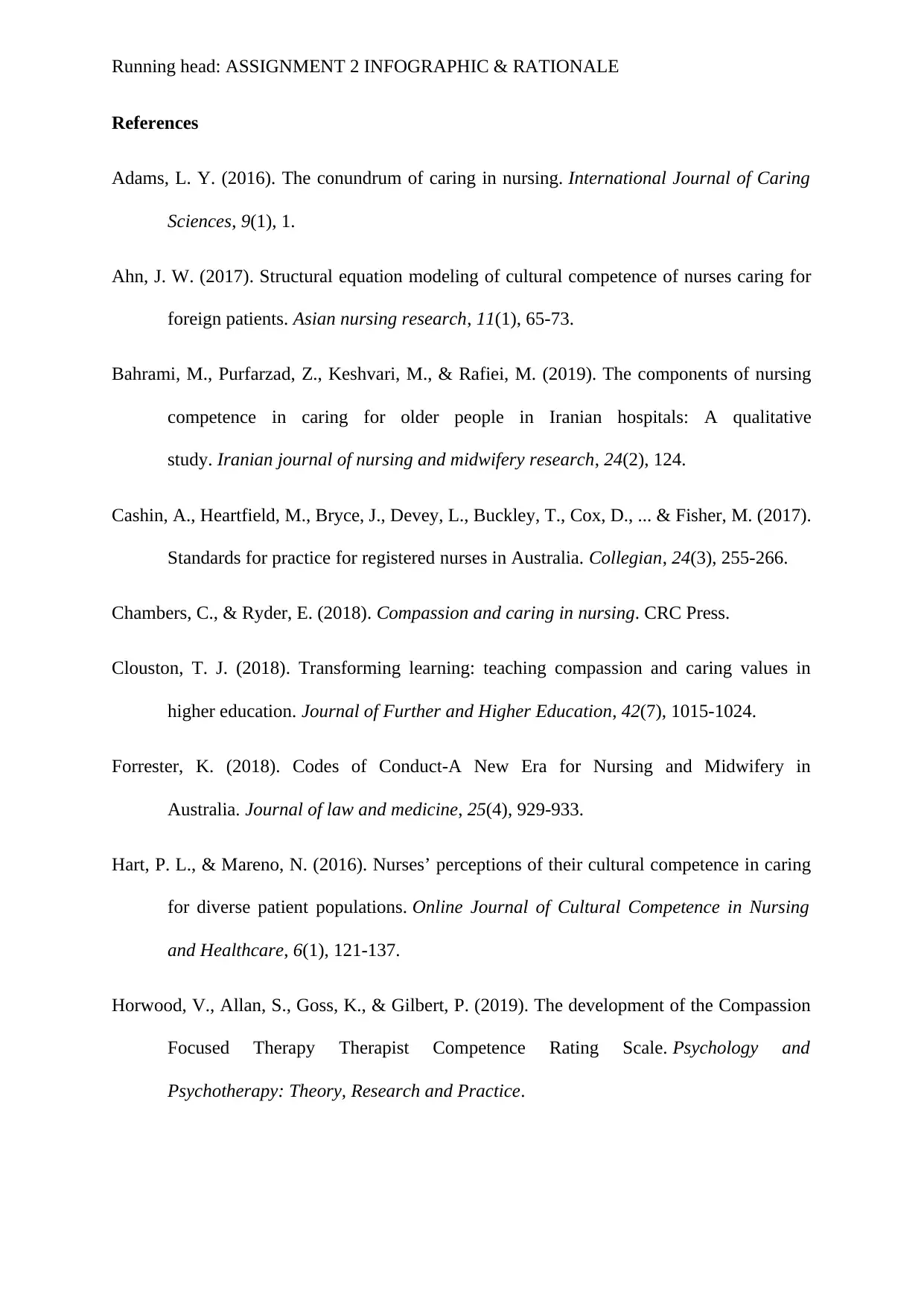
Running head: ASSIGNMENT 2 INFOGRAPHIC & RATIONALE
References
Adams, L. Y. (2016). The conundrum of caring in nursing. International Journal of Caring
Sciences, 9(1), 1.
Ahn, J. W. (2017). Structural equation modeling of cultural competence of nurses caring for
foreign patients. Asian nursing research, 11(1), 65-73.
Bahrami, M., Purfarzad, Z., Keshvari, M., & Rafiei, M. (2019). The components of nursing
competence in caring for older people in Iranian hospitals: A qualitative
study. Iranian journal of nursing and midwifery research, 24(2), 124.
Cashin, A., Heartfield, M., Bryce, J., Devey, L., Buckley, T., Cox, D., ... & Fisher, M. (2017).
Standards for practice for registered nurses in Australia. Collegian, 24(3), 255-266.
Chambers, C., & Ryder, E. (2018). Compassion and caring in nursing. CRC Press.
Clouston, T. J. (2018). Transforming learning: teaching compassion and caring values in
higher education. Journal of Further and Higher Education, 42(7), 1015-1024.
Forrester, K. (2018). Codes of Conduct-A New Era for Nursing and Midwifery in
Australia. Journal of law and medicine, 25(4), 929-933.
Hart, P. L., & Mareno, N. (2016). Nurses’ perceptions of their cultural competence in caring
for diverse patient populations. Online Journal of Cultural Competence in Nursing
and Healthcare, 6(1), 121-137.
Horwood, V., Allan, S., Goss, K., & Gilbert, P. (2019). The development of the Compassion
Focused Therapy Therapist Competence Rating Scale. Psychology and
Psychotherapy: Theory, Research and Practice.
References
Adams, L. Y. (2016). The conundrum of caring in nursing. International Journal of Caring
Sciences, 9(1), 1.
Ahn, J. W. (2017). Structural equation modeling of cultural competence of nurses caring for
foreign patients. Asian nursing research, 11(1), 65-73.
Bahrami, M., Purfarzad, Z., Keshvari, M., & Rafiei, M. (2019). The components of nursing
competence in caring for older people in Iranian hospitals: A qualitative
study. Iranian journal of nursing and midwifery research, 24(2), 124.
Cashin, A., Heartfield, M., Bryce, J., Devey, L., Buckley, T., Cox, D., ... & Fisher, M. (2017).
Standards for practice for registered nurses in Australia. Collegian, 24(3), 255-266.
Chambers, C., & Ryder, E. (2018). Compassion and caring in nursing. CRC Press.
Clouston, T. J. (2018). Transforming learning: teaching compassion and caring values in
higher education. Journal of Further and Higher Education, 42(7), 1015-1024.
Forrester, K. (2018). Codes of Conduct-A New Era for Nursing and Midwifery in
Australia. Journal of law and medicine, 25(4), 929-933.
Hart, P. L., & Mareno, N. (2016). Nurses’ perceptions of their cultural competence in caring
for diverse patient populations. Online Journal of Cultural Competence in Nursing
and Healthcare, 6(1), 121-137.
Horwood, V., Allan, S., Goss, K., & Gilbert, P. (2019). The development of the Compassion
Focused Therapy Therapist Competence Rating Scale. Psychology and
Psychotherapy: Theory, Research and Practice.
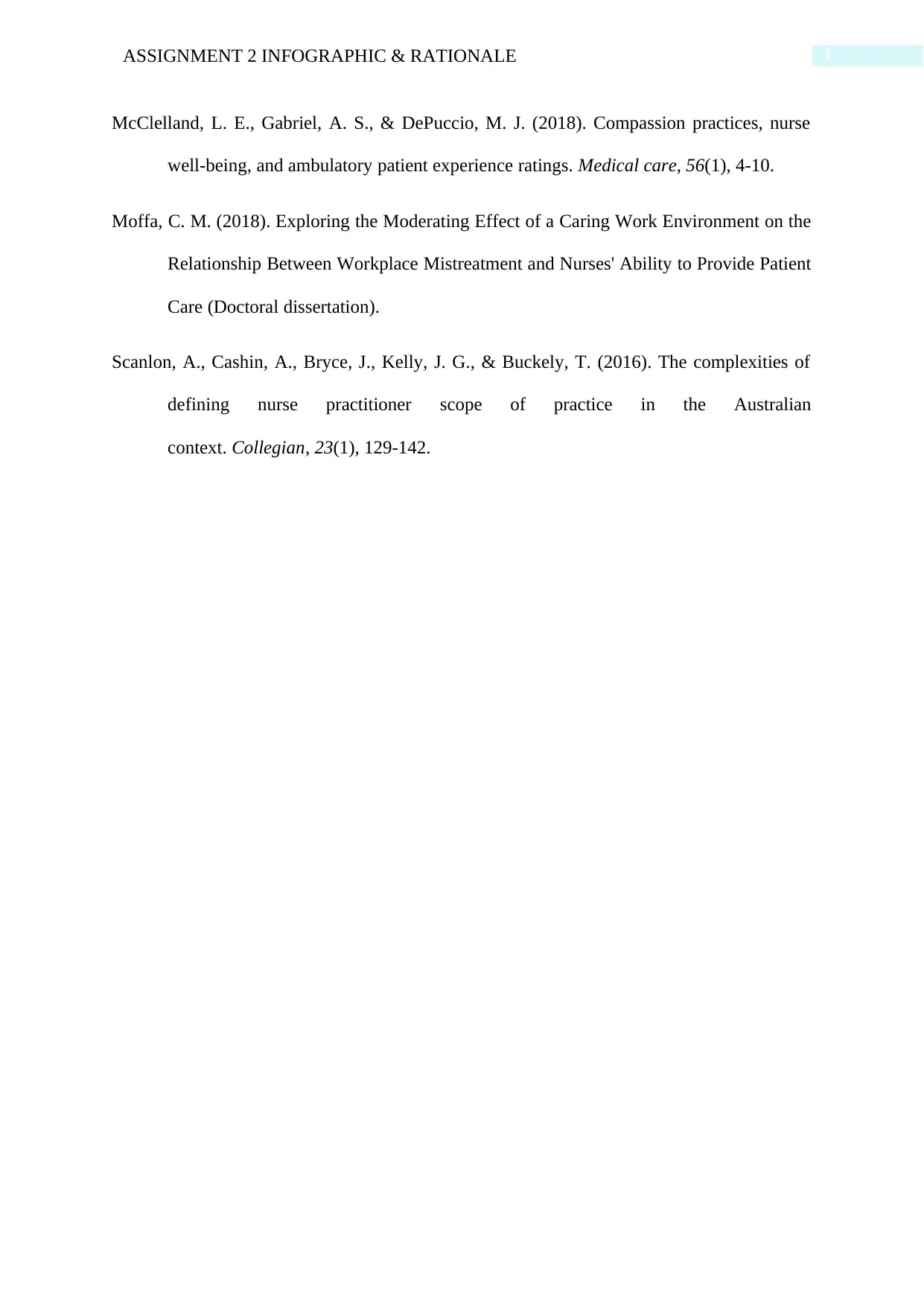
1ASSIGNMENT 2 INFOGRAPHIC & RATIONALE
McClelland, L. E., Gabriel, A. S., & DePuccio, M. J. (2018). Compassion practices, nurse
well-being, and ambulatory patient experience ratings. Medical care, 56(1), 4-10.
Moffa, C. M. (2018). Exploring the Moderating Effect of a Caring Work Environment on the
Relationship Between Workplace Mistreatment and Nurses' Ability to Provide Patient
Care (Doctoral dissertation).
Scanlon, A., Cashin, A., Bryce, J., Kelly, J. G., & Buckely, T. (2016). The complexities of
defining nurse practitioner scope of practice in the Australian
context. Collegian, 23(1), 129-142.
McClelland, L. E., Gabriel, A. S., & DePuccio, M. J. (2018). Compassion practices, nurse
well-being, and ambulatory patient experience ratings. Medical care, 56(1), 4-10.
Moffa, C. M. (2018). Exploring the Moderating Effect of a Caring Work Environment on the
Relationship Between Workplace Mistreatment and Nurses' Ability to Provide Patient
Care (Doctoral dissertation).
Scanlon, A., Cashin, A., Bryce, J., Kelly, J. G., & Buckely, T. (2016). The complexities of
defining nurse practitioner scope of practice in the Australian
context. Collegian, 23(1), 129-142.
1 out of 7
Related Documents
Your All-in-One AI-Powered Toolkit for Academic Success.
+13062052269
info@desklib.com
Available 24*7 on WhatsApp / Email
![[object Object]](/_next/static/media/star-bottom.7253800d.svg)
Unlock your academic potential
© 2024 | Zucol Services PVT LTD | All rights reserved.





